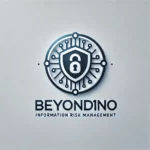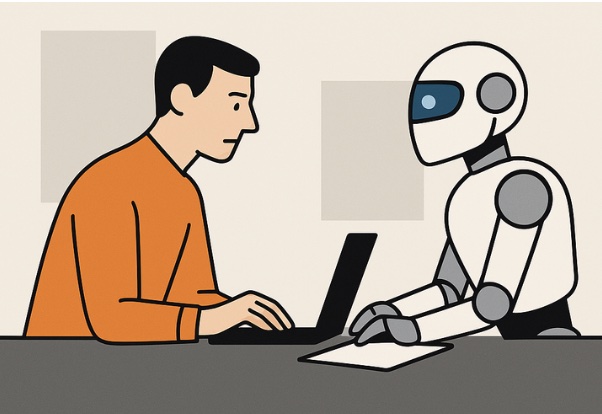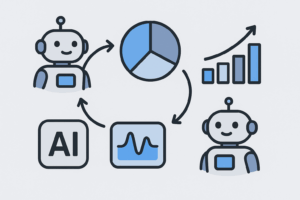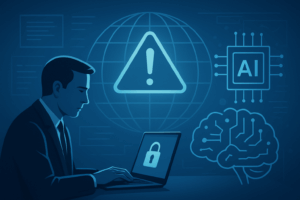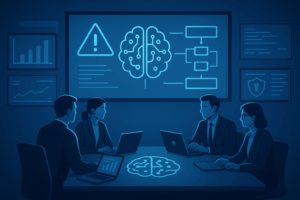Artificial Intelligence (AI) is rapidly transforming how we work—boosting productivity but also raising urgent questions about job security and data safety. With tools like Microsoft Copilot becoming workplace staples and deepfake scams costing millions, AI is reshaping how we work—fueling both excitement and concern. As automation accelerates, professionals and everyday people must weigh its benefits against the risks, especially from a cybersecurity standpoint.
At Beyond1n0, we’re committed to demystifying cybersecurity and AI for all. This article explores how AI is reshaping the workplace, its opportunities, the threat of job displacement, and the critical cybersecurity implications—with real-world examples to ground the discussion.
🚀 AI as a Productivity Powerhouse
AI is revolutionizing workplace efficiency by automating repetitive tasks, improving decision-making, and enabling hyper-personalized workflows. Here’s how:
- Automation of Routine Tasks: Tools like chatbots, virtual assistants (e.g., Grok 3, ChatGPT, and Microsoft Copilot), and robotic process automation (RPA) handle data entry, scheduling, and customer inquiries. For example, Walmart uses AI-powered RPA to process invoices and inventory updates 80% faster than manual methods, freeing employees for strategic tasks.
- Data-Driven Insights: AI analytics platforms uncover trends, predict outcomes, and optimize operations. In cybersecurity, tools like Splunk or Darktrace detect anomalies in real-time, reducing threat response times by up to 60%. For instance, Capital One leverages AI to analyze transaction data, catching fraud faster than traditional methods.
- Personalized Workflows: AI tailors experiences, such as recommending training modules or prioritizing tasks in tools like Asana. A 2024 study by Gartner found AI-driven personalization boosts individual productivity by 20–30%. Marketing teams, for example, use Jasper to draft content, saving hours on ideation.
These tools empower professionals in marketing, finance, and cybersecurity to amplify output without working longer hours.
⚠️ The Flip Side: Job Displacement Concerns
While AI enhances productivity, it also raises fears of job loss, particularly in roles driven by repetition or predictability.
Critical thinking & problem-solving Without reskilling, lower-skill workers risk falling behind, widening income inequality. Meanwhile, AI specialists command salaries from $120,000 to over $200,000, as seen in LinkedIn’s 2025 job trends.
Roles most at Risk:
- Basic accounting roles
- Data entry clerks
- Assembly line workers
- Customer service agents
For example, Amazon’s customer service now relies on AI chatbots for 70% of first-line support, reducing the need for human agents.
The Urgent Need to Upskill: A 2023 McKinsey report estimates 30% of jobs could be automated by 2030. However, the World Economic Forum predicts AI will create 97 million new roles in fields like:
- Data science
- AI governance
- Cybersecurity
- Critical thinking & problem-solving
Without reskilling, lower-skill workers risk falling behind, widening income inequality.
🔐 Cybersecurity Risks of AI in the Workplace
As a cybersecurity educator, I see AI as a double-edged sword. It strengthens security but introduces vulnerabilities:
- Data Privacy & Misconfiguration: AI systems rely on massive datasets, including sensitive employee or customer data. In 2024, Clearview AI’s misconfigured database exposed 10,000 records due to poor API security, highlighting the need for robust access controls.
- AI-Powered Attacks: Cybercriminals use AI to craft realistic phishing emails and deepfakes, boosting attack success rates by 30%. For example, a 2025 deepfake scam tricked a finance firm into transferring $1M using an AI-generated CEO voice.
- Bias & Ethics: AI can inherit biases, leading to unfair decisions. In 2018, Amazon’s AI hiring tool favored male candidates, prompting its cancellation. Such risks invite regulatory fines under laws like GDPR or the EU AI Act.
- Over-Reliance on AI: A 2025 ransomware attack costing $2M occurred due to a misconfigured AI firewall, underscoring the need for human oversight.
🧭 Balancing Productivity and Job Security
The challenge isn’t choosing between productivity and job security—it’s designing workplaces where AI augments human potential. Here’s how:
- For Employers:
- Invest in Upskilling: Use platforms like LinkedIn Learning or Coursera to build AI and cybersecurity skills.
- Be Transparent: Communicate AI’s role as an augmentative tool, as Google does with its AI initiatives.
- Secure the Stack: Adopt zero-trust frameworks and tools like Grok 3’s DeepSearch mode for real-time threat analysis (available with SuperGrok—see x.ai/grok for details).
- For Employees:
- Get AI-Literate: Learn tools like Microsoft Copilot or Google’s AI suite. Free tutorials are on YouTube or X (#AIWorkplace).
- Sharpen Soft Skills: Focus on creativity and problem-solving—skills AI can’t replicate.
- Stay Cyber-Aware: Follow X hashtags like #CyberSec for updates on AI-driven threats.
- For Society:
- Advocate for Policy: Support ethical AI regulations like the EU AI Act.
- Promote Shared Learning: Join X discussions (#AIWorkplace) or local meetups.
🔄 The Future: Collaborate With AI, Don’t Compete Against It
AI isn’t the enemy—it’s a partner when used responsibly. At Beyond1n0, I use tools like Grok 3 to accelerate research, saving hours while keeping my voice authentic. In cybersecurity, AI tools like CrowdStrike detect threats faster, but human analysts make critical decisions.
View AI as a collaborator, not a competitor!
💬 Let’s Keep the Conversation Going
What’s your take on AI in your workplace?
💬 Share your thoughts in the comments below
🐦 Post on X using #AIWorkplace
Let’s shape a future where AI works with us—not instead of us.
